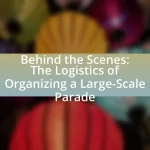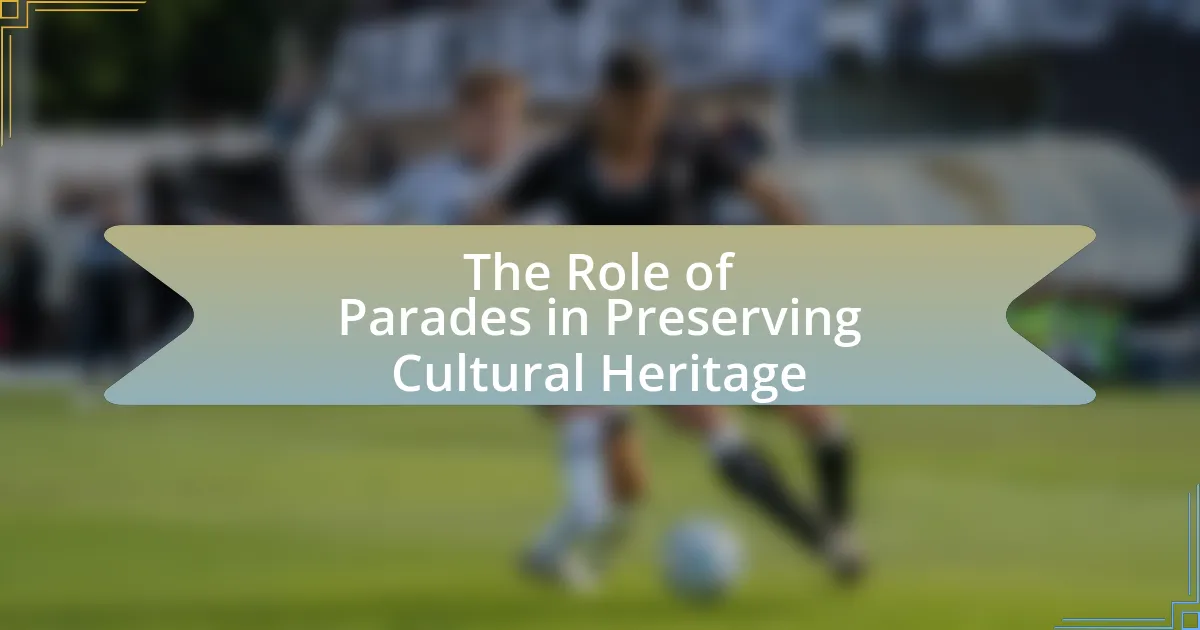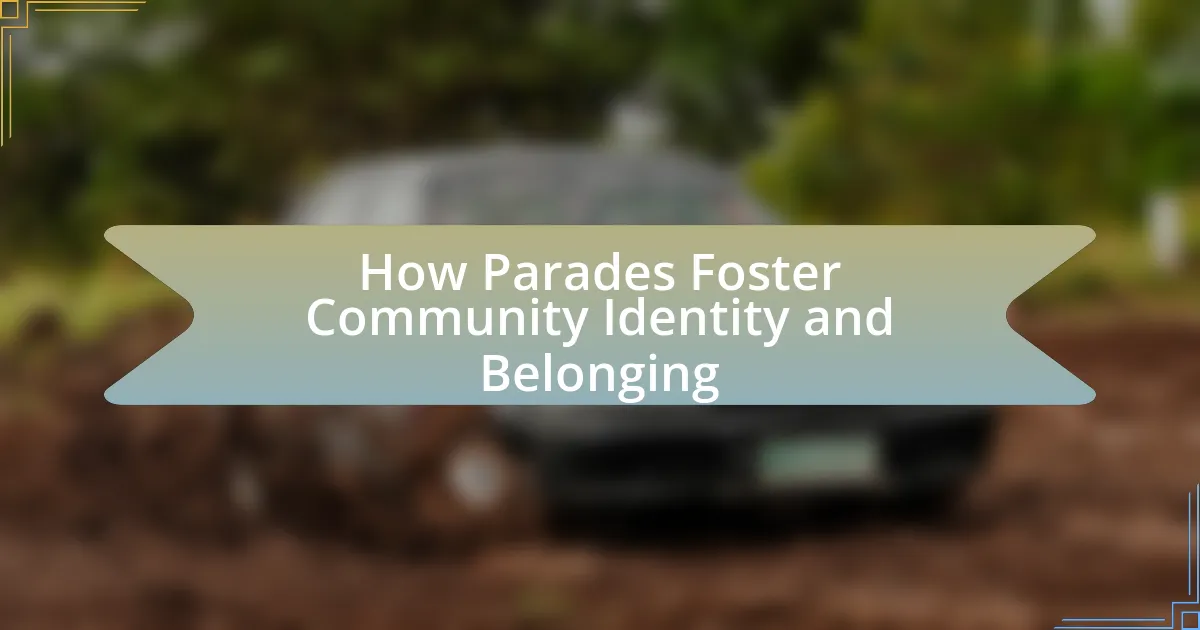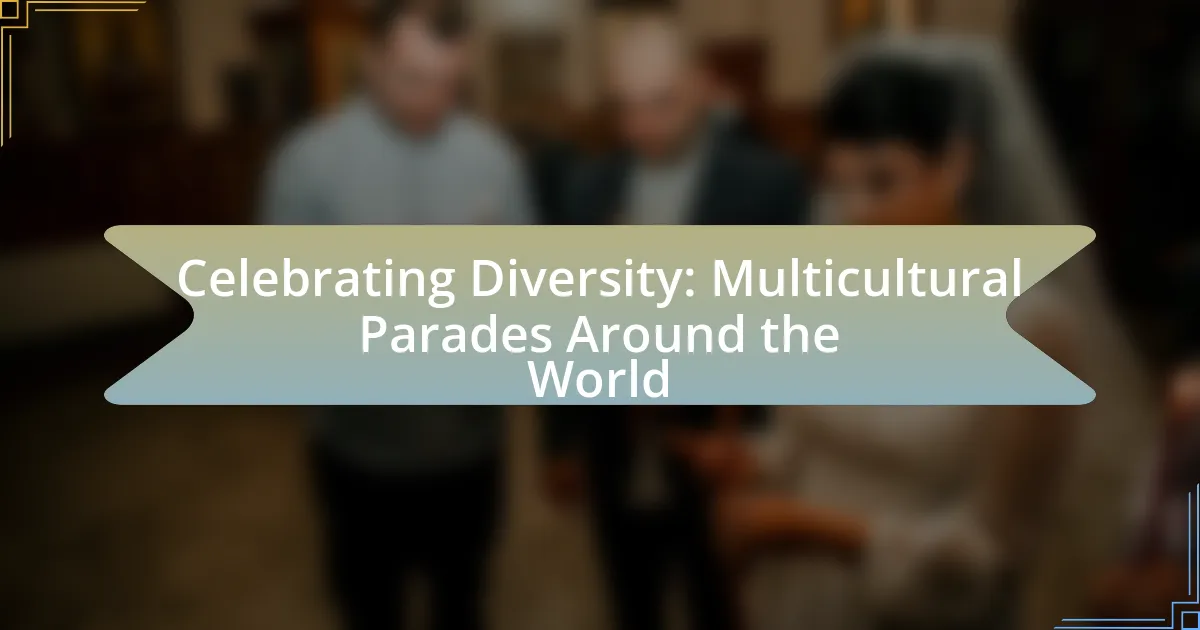Parade celebrations in urban environments are organized public events that feature processions of people, vehicles, and floats, often accompanied by music and entertainment. These events have evolved from historical religious and military displays to modern festivities that reflect cultural diversity and community identity, such as Pride and Thanksgiving parades. The article explores the historical influences on parades, their role in fostering community engagement and identity, the economic benefits they provide, and the challenges organizers face, including logistical issues and safety concerns. Additionally, it categorizes different types of parades and highlights best practices for successful organization, emphasizing the importance of inclusivity and representation in these urban celebrations.

What are Parade Celebrations in Urban Environments?
Parade celebrations in urban environments are organized public events featuring a procession of people, vehicles, and floats, often accompanied by music and entertainment. These celebrations serve various purposes, including cultural expression, community bonding, and the commemoration of significant events or holidays. Historically, parades have evolved from religious and military displays to modern festivities that reflect diverse cultural identities, such as Pride parades and Thanksgiving Day parades. For instance, the Macy’s Thanksgiving Day Parade in New York City, established in 1924, showcases this evolution by combining entertainment with a celebration of American culture.
How have parade celebrations evolved over time?
Parade celebrations have evolved from simple religious or military processions into complex, multifaceted events that reflect cultural, social, and political themes. Historically, parades served as a means to display power and unity, such as Roman triumphs or medieval festivals. In the 19th century, parades began to incorporate elements of entertainment and community engagement, exemplified by the introduction of floats and marching bands during events like Mardi Gras and Thanksgiving parades. The 20th century saw parades become platforms for social movements, with events like the Stonewall Riots parade advocating for LGBTQ+ rights. Today, parades often blend tradition with modernity, utilizing technology and social media for broader participation and visibility, as seen in events like the New Year’s Day Rose Parade, which showcases elaborate floral floats and attracts global audiences.
What historical events influenced the development of urban parades?
The development of urban parades has been significantly influenced by historical events such as religious festivals, military victories, and civic celebrations. Religious festivals, particularly in ancient civilizations, often included processions that laid the groundwork for modern parades, as seen in the Roman Saturnalia and Christian celebrations like Carnival. Military victories, exemplified by Roman triumphs, showcased the power of the state and fostered public unity, leading to the tradition of parading victorious armies through city streets. Additionally, civic celebrations, such as Independence Day parades in the United States, emerged from the need to commemorate significant national events, reinforcing community identity and pride. These historical contexts illustrate how urban parades evolved as expressions of cultural, religious, and civic significance throughout history.
How did cultural shifts impact the nature of parade celebrations?
Cultural shifts significantly transformed parade celebrations by altering their themes, participants, and societal roles. For instance, the civil rights movement in the 1960s led to parades that emphasized social justice and equality, reflecting the changing values of society. Additionally, the incorporation of diverse cultural elements in parades, such as LGBTQ+ pride parades, showcases how shifts in societal acceptance and representation have influenced the nature of these events. Historical examples include the transition of Mardi Gras from a religious observance to a celebration of cultural diversity, highlighting the impact of cultural evolution on parade dynamics.
What role do parades play in urban communities?
Parades serve as vital cultural and social events in urban communities, fostering a sense of identity and belonging among residents. They provide opportunities for community engagement, allowing diverse groups to come together in celebration, which enhances social cohesion. For instance, events like Mardi Gras in New Orleans and the Pride Parade in cities worldwide attract thousands, showcasing local traditions and promoting inclusivity. Additionally, parades can stimulate local economies by increasing foot traffic to businesses and attracting tourism, as evidenced by the economic impact studies conducted on major parades that report significant revenue boosts for host cities.
How do parades foster community engagement and identity?
Parades foster community engagement and identity by providing a platform for collective celebration and participation among residents. They encourage social interaction, allowing individuals to connect with their neighbors and local culture, which strengthens community bonds. For instance, studies show that parades often feature local organizations, businesses, and cultural groups, showcasing the diversity and uniqueness of the community. This representation fosters a sense of belonging and pride among participants, reinforcing local identity. Additionally, parades can attract visitors, enhancing community visibility and economic activity, further solidifying the community’s identity in the broader urban environment.
What economic benefits do urban parades provide to cities?
Urban parades provide significant economic benefits to cities by boosting local tourism and generating revenue for businesses. These events attract large crowds, which increases spending in hotels, restaurants, and retail shops. For instance, a study by the National Association of City Transportation Officials found that major parades can generate millions in economic impact; the 2019 Rose Parade in Pasadena, California, brought in an estimated $30 million in visitor spending. Additionally, parades create temporary jobs and stimulate local economies through increased demand for services such as security, transportation, and event planning.
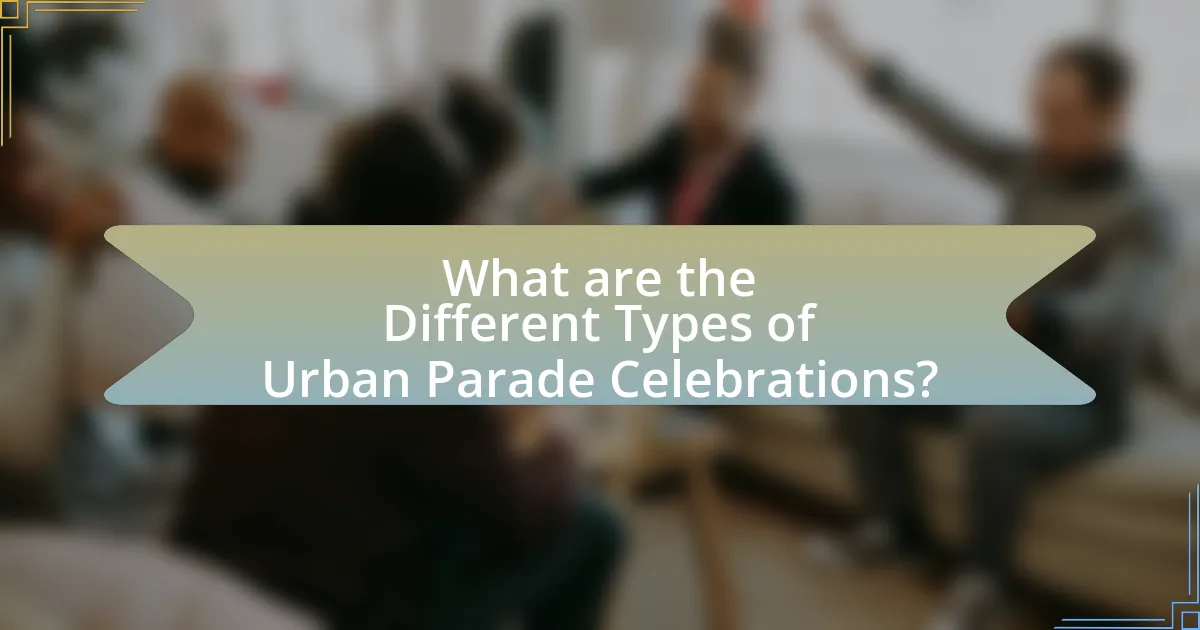
What are the Different Types of Urban Parade Celebrations?
Urban parade celebrations can be categorized into several distinct types, including cultural parades, holiday parades, pride parades, and commemorative parades. Cultural parades, such as the Chinese New Year Parade, showcase traditions and heritage, while holiday parades, like the Macy’s Thanksgiving Day Parade, celebrate specific festive occasions. Pride parades, exemplified by events like San Francisco Pride, advocate for LGBTQ+ rights and visibility. Commemorative parades, such as Memorial Day parades, honor historical events or figures. Each type serves a unique purpose and reflects the diverse social fabric of urban environments.
How do cultural parades differ from civic parades?
Cultural parades primarily celebrate specific ethnic, religious, or artistic traditions, while civic parades focus on community pride, local achievements, or governmental events. Cultural parades often feature traditional costumes, music, and dance that reflect the heritage of a particular group, such as the Chinese New Year Parade showcasing dragon dances and lanterns. In contrast, civic parades, like Independence Day parades, typically include floats, marching bands, and representatives from local organizations, emphasizing civic pride and community involvement. This distinction highlights the purpose and content of each type of parade, with cultural parades fostering cultural expression and civic parades promoting community unity and local identity.
What are the key characteristics of cultural parades?
Cultural parades are characterized by vibrant displays of cultural heritage, community participation, and artistic expression. These events typically feature colorful costumes, traditional music, and dance performances that reflect the cultural identity of the participating groups. Additionally, cultural parades often serve as a platform for social and political messages, promoting unity and awareness within diverse communities. Historical examples, such as the Mardi Gras in New Orleans, illustrate how cultural parades have evolved to incorporate local traditions while fostering community engagement and celebration.
How do civic parades reflect local governance and community values?
Civic parades reflect local governance and community values by showcasing the priorities and identity of a community through organized public displays. These events often highlight local traditions, celebrate civic pride, and promote social cohesion, which are essential aspects of governance. For instance, parades may feature local leaders, cultural organizations, and community groups, demonstrating the involvement of governance in fostering community engagement. Additionally, the themes of parades can align with local policies or initiatives, such as promoting diversity or environmental awareness, thus reinforcing the values upheld by local authorities. Historical examples include the annual Rose Parade in Pasadena, California, which emphasizes community spirit and local culture, reflecting the city’s governance focus on tourism and community involvement.
What are some notable examples of urban parades worldwide?
Notable examples of urban parades worldwide include the Rio Carnival in Brazil, the Macy’s Thanksgiving Day Parade in the United States, and the Notting Hill Carnival in the United Kingdom. The Rio Carnival, held annually, is renowned for its vibrant samba parades and attracts millions of participants and spectators, making it one of the largest festivals globally. The Macy’s Thanksgiving Day Parade, established in 1924, features large balloons and floats, drawing around 3 million attendees in New York City each year. The Notting Hill Carnival, celebrated since 1966, showcases Caribbean culture and music, with over 2 million people attending annually in London. These parades exemplify the cultural significance and communal spirit of urban celebrations.
How do these parades showcase local traditions and diversity?
Parades showcase local traditions and diversity by featuring cultural performances, traditional costumes, and community participation that reflect the unique heritage of the area. For instance, many parades include floats and displays that highlight historical events, local folklore, and ethnic customs, allowing participants and spectators to engage with the cultural narratives of their community. Additionally, parades often incorporate music and dance styles from various cultural backgrounds, promoting inclusivity and celebrating the multicultural fabric of urban environments. This representation of diverse traditions fosters a sense of belonging and pride among community members, reinforcing social cohesion and cultural awareness.
What lessons can be learned from successful urban parades?
Successful urban parades demonstrate the importance of community engagement and effective organization. These events thrive when local stakeholders, including businesses, residents, and cultural organizations, collaborate to create a shared vision. For instance, the annual Macy’s Thanksgiving Day Parade in New York City involves extensive planning and coordination among various entities, resulting in a highly anticipated event that fosters community spirit and tourism. Additionally, successful parades often incorporate diverse cultural elements, reflecting the demographics of the city and enhancing inclusivity. This approach not only attracts a wider audience but also strengthens community ties, as seen in the San Francisco Pride Parade, which celebrates LGBTQ+ culture while promoting acceptance and unity.
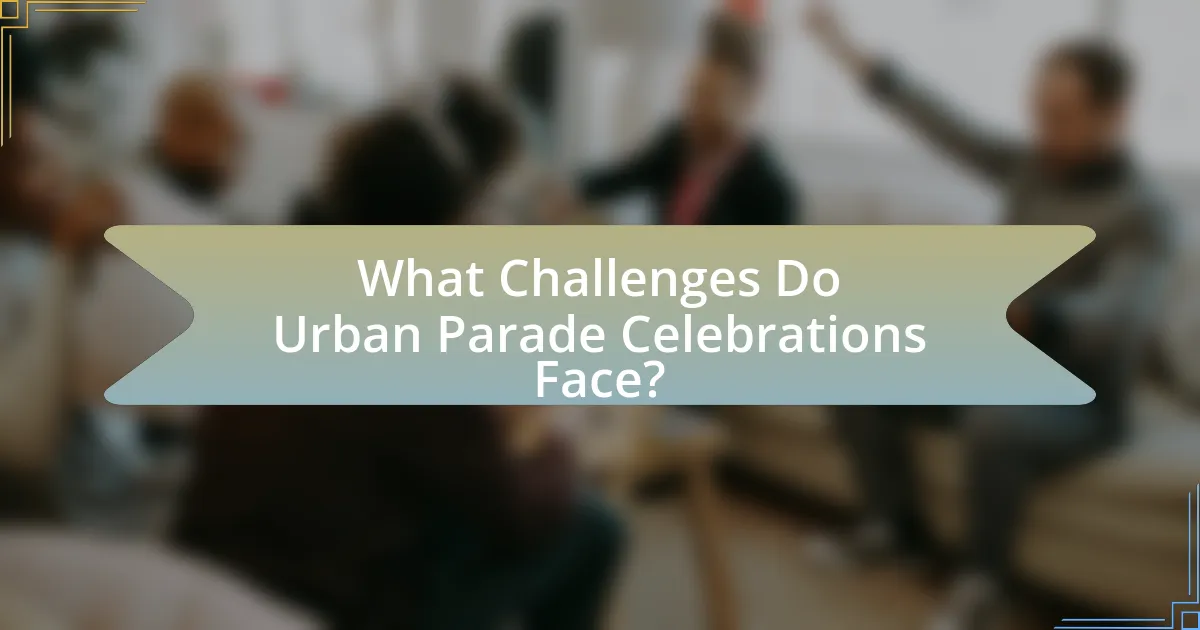
What Challenges Do Urban Parade Celebrations Face?
Urban parade celebrations face several challenges, including logistical issues, safety concerns, and community engagement. Logistical issues arise from the need to coordinate permits, street closures, and crowd management, which can complicate planning and execution. Safety concerns are heightened due to large gatherings, necessitating measures to prevent accidents and ensure public security, as evidenced by incidents at past events that led to injuries or fatalities. Community engagement is also a challenge, as organizers must balance diverse interests and ensure that the parade reflects the values and culture of the local population, which can be difficult in multicultural urban settings.
How do logistical issues impact the planning of parades?
Logistical issues significantly impact the planning of parades by determining the feasibility and execution of the event. Factors such as route selection, crowd control, transportation, and resource allocation must be meticulously managed to ensure safety and smooth operations. For instance, cities often require detailed permits and coordination with law enforcement to manage traffic and public safety, as seen in the annual Macy’s Thanksgiving Day Parade, which involves extensive planning to accommodate large crowds and secure necessary road closures. Additionally, logistical challenges can lead to increased costs and potential delays, affecting the overall success and enjoyment of the parade.
What are common challenges related to crowd management?
Common challenges related to crowd management include ensuring safety, maintaining order, and facilitating efficient movement. Safety concerns arise from the potential for overcrowding, which can lead to accidents or emergencies; for instance, the 2015 Love Parade disaster in Germany resulted in 21 fatalities due to crowd surges. Maintaining order is crucial to prevent conflicts or disturbances, especially in diverse crowds where differing opinions may clash. Efficient movement is essential to avoid bottlenecks, which can hinder access to emergency services and create panic. These challenges necessitate strategic planning and real-time monitoring to effectively manage large gatherings in urban environments.
How do weather conditions affect parade celebrations?
Weather conditions significantly impact parade celebrations by influencing attendance, safety, and overall enjoyment. For instance, inclement weather such as rain or snow can deter spectators from attending, leading to lower turnout rates. Historical data from events like the Macy’s Thanksgiving Day Parade shows that severe weather can result in a 30% decrease in attendance. Additionally, adverse weather conditions can pose safety risks, prompting organizers to implement emergency protocols or even cancel events, as seen during the 2018 Philadelphia Thanksgiving Day Parade when high winds led to the cancellation of certain floats. Furthermore, favorable weather enhances the experience, encouraging larger crowds and more vibrant festivities, as evidenced by the increased participation in parades held on sunny days compared to those held in poor weather.
What social issues can arise during urban parades?
Social issues that can arise during urban parades include overcrowding, public safety concerns, and potential for violence. Overcrowding can lead to difficulties in crowd management, resulting in injuries or fatalities, as seen in incidents like the 2017 New Year’s Eve celebration in Times Square, where large crowds created dangerous conditions. Public safety concerns often manifest through increased crime rates, as parades can attract pickpockets and other criminal activities, evidenced by reports from various cities during major events. Additionally, the potential for violence can escalate due to tensions among different groups, which has been documented in events like the 2018 Pride Parade in Tel Aviv, where clashes occurred between opposing factions. These issues highlight the complexities of managing large gatherings in urban settings.
How do parades address issues of inclusivity and representation?
Parades address issues of inclusivity and representation by actively showcasing diverse communities and promoting visibility for marginalized groups. For instance, many parades, such as Pride parades, explicitly celebrate LGBTQ+ identities, allowing individuals to express themselves freely and fostering a sense of belonging. Additionally, parades often include various cultural groups, highlighting their traditions and contributions, which enhances community cohesion and awareness. Research indicates that events like the New York City Pride Parade have significantly increased visibility and acceptance of LGBTQ+ individuals, contributing to broader societal changes regarding inclusivity.
What measures can be taken to ensure safety and security during parades?
To ensure safety and security during parades, organizers should implement comprehensive planning that includes crowd control measures, emergency response protocols, and collaboration with law enforcement. Effective crowd control can be achieved through designated entry and exit points, barriers to manage flow, and trained personnel to monitor the crowd. Emergency response protocols should include clear communication channels, first aid stations, and evacuation plans in case of emergencies. Collaboration with law enforcement is crucial, as they can provide security personnel, surveillance, and rapid response capabilities. Historical data shows that cities with well-coordinated safety measures, such as New York City during the Macy’s Thanksgiving Day Parade, experience significantly fewer incidents, highlighting the effectiveness of these strategies.
What are Best Practices for Organizing Successful Urban Parades?
Best practices for organizing successful urban parades include thorough planning, community engagement, and effective communication. Thorough planning involves securing necessary permits, coordinating with local authorities, and establishing a detailed timeline for the event. Community engagement is crucial; involving local businesses, schools, and residents fosters support and participation, enhancing the parade’s atmosphere. Effective communication ensures that all stakeholders, including participants and spectators, are informed about the parade’s schedule, route, and safety measures. Historical examples, such as the Macy’s Thanksgiving Day Parade, demonstrate that meticulous organization and community involvement lead to successful events, attracting large crowds and positive media coverage.
How can organizers effectively engage the community in parade planning?
Organizers can effectively engage the community in parade planning by implementing inclusive strategies that encourage participation and feedback. This can be achieved through community meetings, surveys, and social media platforms where residents can share their ideas and preferences. For instance, a study by the National Endowment for the Arts found that community involvement in event planning increases attendance and satisfaction, demonstrating that when people feel their voices are heard, they are more likely to participate actively. Additionally, collaborating with local organizations and schools can foster a sense of ownership and pride among community members, further enhancing engagement in the parade planning process.
What strategies can be implemented to enhance the parade experience for participants and spectators?
To enhance the parade experience for participants and spectators, organizers can implement strategies such as improved crowd management, interactive activities, and enhanced accessibility. Effective crowd management ensures safety and comfort, which can be achieved through designated viewing areas and clear signage. Interactive activities, such as workshops or live performances, engage spectators and create a more immersive experience. Additionally, enhancing accessibility by providing ramps, seating for individuals with disabilities, and sensory-friendly spaces ensures that all participants can enjoy the event. These strategies have been shown to increase overall satisfaction and participation in urban parades, as evidenced by studies indicating that well-organized events lead to higher attendance and positive feedback from both participants and spectators.


